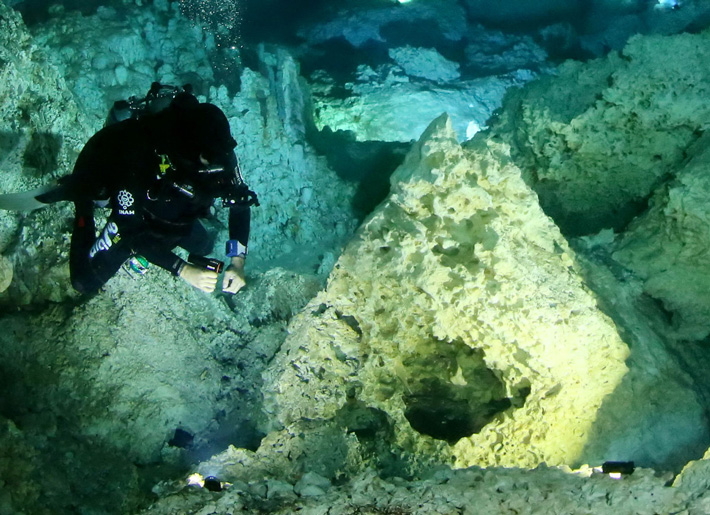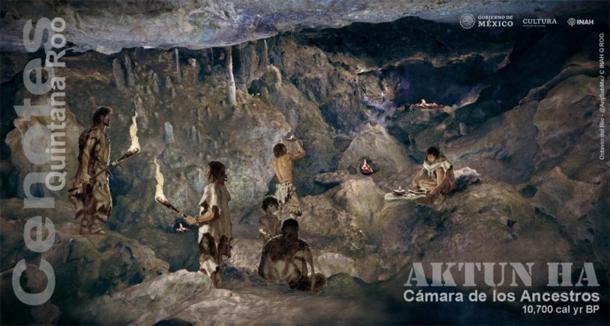Scientists find evidence of fires built in Yucatán cave 10,000 years ago
In Mexico the oldest traces of charcoal ever discovered is found in a cenote of the Yucatán Peninsula.
Recent archeological evidence from tests of burnt charcoal has shown that the first inhabitants on the Yucatán peninsula in Mexico constructed bonfires in the cave now flooded with water for over 10,000 years.
Chemical charred samples of 14 prehistory bonfires were obtained by the scientists of the National Autonomous University of Mexico (UNAM) in 2017 and 2018 from the cenote of Aktun Ha (sinkhole) at a distance of around nine kilometers from Tulum, Quintana Roo.
In late April this year archaeologist Luis Alberto Martos López authored an article about the charcoal sample analysis which was published in the journal Geoarchaeology detailing how they had all been found in the Ancestors Chamber of the Aktun Ha cenote.
The subsequent study included controlled heating experiments, nuclear magnetic resonance spectroscopy, and carbon dating to determine the fires had burned between “10,250 and 10,750 years ago.”

Located beside the Tulum-Cobá highway the cenote is known locally as the “Car Wash,” for before becoming a major heritage and tourist attraction taxi drivers used to get water for washing their cars.
The dating of the fires corresponds to the early Holocene period, which is the geological epoch we are still in that began more than 11,000 years ago at the end of the last Ice Age, and the 14 charcoal remnants have been called the “oldest ever discovered in a Yucatán Peninsula cenote” according to a report in Mexico News Daily.
Mr. Martos López said this finding is helping him and his fellow scientists to reconstruct the history of fire in the Americas which he believes is of great importance for the “study of evolution and human migration.”
Before this discovery was cemented as bonafide archaeology the scientists first had to negate the possibility that waters from elsewhere had swept the charcoal remains into the cenote cave.
And increasing this possibility, in 2018, the discovery of an underground link between the Sac Actun underwater river system which is approximately 263 kilometers long, and the Dos Ojos system in Tulum which is 84 kilometers long, which Geo Mexico called “the world’s largest underwater cave system .” However, the archaeologists were able to determine that the fires had been burned locally to the cenote.

Analysis of the charcoal revealed the fires had reached temperatures as high as 600 C and archaeological divers discovered stone tools and artifacts in the cave, such as hammers and scraper tools, suggesting it was a temporary shelter where butchery and cooking occurred.
But the researchers say the early hunter-gatherers who lived on the Yucatán Peninsula may have used the Ancestors Chamber “for ritual purposes”.
Describing how the ancient sacred site was accessed over 10 millennia ago, Martos explained that to get into the cave in prehistoric times people would have had to crawl through “a narrow five-meter-long tunnel whose entrance was hidden by a mound of rocks.”
At the end of the tunnel, the Ancestors Chamber of the Aktun Ha cenote measures 20 square meters high and five to six meters wide, and around 10,000 years ago a natural well-formed at the back of the cave and Martos explained that before it was flooded with water it had been “well ventilated allowing the fire smoke to escape.”

This new discovery jigsaw into the content of a Feb 2020 news article I wrote for Archaeology org about new research published in the journal PLOS One detailing the discovery of “a 9,900-year-old human skeleton,” found in the Chan Hol cave, near the Tulum archaeological site in Quintana Roo.
Belonging to a woman who had died in her 30s, the archaeologists referred to her as being among the “first people to set foot in the Americas.”
In context, when this 9,000-year-old woman sat around a fire at night considering where she might have come from, her fire burning ancestors who left the charcoal behind in the Aktun Ha cenote were as distant to her as the Norman Invasion of Britain in 1066 AD is to us, having occurred almost 1,000 before our present day.
It seems that as technologies rapidly advance, every few months archaeologists in Mexico push back the anthological clock penetrating deeper into our Ancient Origins, and very soon we may have an answer to the big question: where did the 10,000-year-old fire starters come from?





